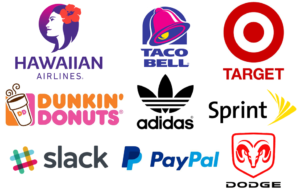
Allow me to let you in on a little secret.
There are two paths to success.
The first approach is to walk your own path and brave the ups that downs that dot your way until you reach the destination.
The second route, frequented by the most successful people, entails learning from the mistakes of others and playing it safe by following along in the wake of successful people.
Whether you’re running a small business or working for a well-established business, branding is something that you need to keep an eye on.
Sure, fortune 500sare blessed with generous marketing budgets which they dispense with easily to experiment with their branding. But unfortunately, small-scale-companies operating on shoe-string budgets need to act and think smart. They don’t have a lot of room to experiment and try out things that can go southwards and cost them an arm and a leg. Therefore, we are about to investigate the psychology of branding by which you can take-away lessons from famous brands without even splurging a dime on your branding efforts.
Before you embark on the entrepreneurial journey, the important thing to remember is that branding is all about the experience.
When Jim Meehan was looking to incorporate a spark of uniqueness in his bar, he came up with a splendid idea. With his pockets turned out, there was not much he could do. Luckily, one of his friends was selling an old phone booth for a throw-away price. Jim Meehan jumped on the opportunity and turned it into his bar entrance.
Whenever someone wanted to enter the bar, they dialled the phone and a secret door would appear, leading to the bar. The idea was new, so it spread like wildfire.
This also proved that branding has nothing to do with the size of the company. It’s all about implementing the right ideas at the right time.
It is assumed that Entrepreneurs and small business owners cannot learn anything from big brands because when it comes to branding, small brands follow a different approach than the bigger fish in the sea. And hence, people assume that the most successful companies do something different than small brands.
Regardless of this, startups can learn a lot from highly successful brands.
Let us delve into invaluable branding lessons which small brands can learn from the world’s most popular brands.
1) A powerful brand starts with a logo
As the age-old adage has it, the brand is all about the logo.
The company name and brand logo are two crucial elements that play an important role in the branding of your company.
A brand is the collective sum of experiences that a customer is exposed to, right from the logo through to the final delivery of the product.
A strong brand communicates the company values via the brand logo.
How does it do it?
Simple. By establishing credibility and fostering trust among customers.
Successful brands have the simplest names. Names which can be spelled out, reminisced and easily pronounced without the lapse of the tongue.
This is important because you want customers to remember your company.
Brainstorming a unique business name that reflects what your business is all about, is not easy. If you are facing a creativity block, you can always leverage a free business name generator to come up with the right-fit name for your business.
When coming up with a business name, it is, however, necessary to introspect and ask yourself:
- What are the goals of your company?
- How do the customers perceive your brand?
- How can you differentiate your brand from the competitors on the block?
These questions are valid not only when selecting the identity for your company, but these will guide you during the logo design process as well.
When designing or redesigning a logo for your company, ensure that the logo reflects the values and goals of your company.
A professional web design agency almost always starts off with a questionnaire. A research shows that the right choice of colors can improve the readership by 40%, making it easy for potential customers to read and engage on your website.
It only takes 10 seconds to compel your customer and create a strong brand logo impression of the brand.
A study shows that 77% of consumers make a purchase, due to the brand name. A famous brand name can become a verb akin to Google.
You must put your logo at the centre of your advertising and marketing activities. Once the logo is associated with your brand, it will be easier for your brand to communicate its message across.
2) What is the purpose of your brand?

Today, to create a successful brand, it is important to start with a purpose in mind.
The purpose evolves with the changing demographics.
This generation carries an impressive buyer persona which makes it easy for marketers to engage them by leveraging the purpose of the brand.
Moreover, setting a purpose in place is appealing to the young people across the globe. This trend is consistent across the globe, witnessed alike in the world’s biggest companies as well as startups and small-scale businesses.
91% of consumers prefer to buy from an authentic brand rather than a dishonest one.
But it’s necessary to understand who your target market is, and how is their perception changing over the years, and what your brand can do to leave a lasting impression on your audience.
3) Innovate or Die
One of the key traits of successful websites is that they create a strong impression among customers by innovating regularly.
For instance, Tesla is a market leader in electric cars while Apple takes the centre stage in computer graphics. But in the BrandZ 2018 report, Disney stands ahead of both Apple and Tesla due to its awe-inspiring Magic Band – making it a breeze for theme park visitors to travel lighter by allowing them to enter the parks, unlock their Disney Resort hotel room and buy food and merchandise, in addition to offering FastPass+ access to all the experiences they have selected online.
There is no one-form-of-innovation.
For instance, it takes more than sheer luck to design products that go viral.
How can you compete with large-scale organizations with their piles of gold and their stellar repute?
Simple. Understand how people think and get in their shoes.
By getting to grips with human psychology, you can influence the buying behaviour of customers.
Emotions play a vital role in motivating people to buy your product. If you’re able to tap into their emotions, you can coax them into buying from you.
The good news is that by understanding the myriad design principles, you can develop products which can stick in the eyes of the customers.
Creative people are often labelled as crazy and mysterious creatures. And yet, when it comes to innovation, the solutions that these people give are of incredible value.
What if I tell you that there is a method by which you can act and think like real innovators? You too can innovate and solve problems creatively.
Embrace, ‘Design Thinking’, a method used by everyday designers and creative to think methodologically to come up with creative solutions for each client. The path to innovation passes through empathizing, brainstorming, prototyping, and testing.
4) Big Brands stay memorable
Of course, you’re bombarded with thousands of messages every day. Your Inbox abounding, your text messaging folders brimming to the full.
It is nearly impossible for brands to stand out from the crowd, and when we talk about the smaller fish in the sea, the challenge is even harder. The difference, however, is that big brands articulate with authenticity and leaderships pilling from every word and action.
For instance, highly successful brands engage with their audience on Facebook and Twitter. They receive feedback, get applauded or even pampered by delivering supreme value to their loyal customers.
One key takeaway is that successful brands don’t sport their sales hat all the time. In fact, you’ll mostly see those educating clients on the benefits of using the products.
Although some startups do follow this practice, the common mistake they make is to rely on stock photos and templates to take all the pain for them. Therefore, you need to learn from the market leaders.
While planning your content, ask yourself if the content is relevant to your audience base, or is it just a fuller? Are you putting your social media profiles to effective use, or are you the self-pompous airbag that customers find a nuisance?
Each interaction that you have with your audience needs to be authentic. There is no one way to succeed in the arena of social media. You need to keep testing to see what works for you.
To wrap things up
Most successful brands are not just efficacious because of some fluke of luck. They worked hard for it. When establishing a brand, reputation is all the more important for smaller brands. Treat customers with respect. Listen to them and help them solve their problems and pain-points.
No need to rush things. If your customers are not happy, ask them why, and what you can do to make them feel comfortable with your brand?
Starting a business is easy, but to keep the business running is a great deal. And to keep the business running you need sales and revenue. The only way you’ll get sales is by raising your voice in the crowd and offering something unique.
You don’t need thousands of dollars to market your product, you just need some creative, crazy people who are willing to take the leap and make your brand stand out from the crowd.




